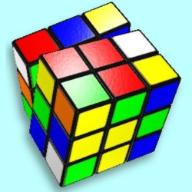The sides of a triangle are in the ratio of 1/2:1/3:1/4. If the perimeter is 52 cm, the length or the smallest side is?
2021-04-13 4:41 pm
The answer is 12 cm. Could you please show me how?
回答 (7)
2021-04-13 8:47 pm
✔ 最佳答案
I'd first multiply all the fractions by the LCD of 12 to get rid of denominators.12*½ : 12*⅓ : 12*¼
= 6 : 4 : 3
Now think of the sides as 6k, 4k and 3k respectively. These add up to 52 cm.
6k + 4k + 3k = 52
13k = 52
k = 4
The sides are therefore:
6k → 6(4) = 24 cm
4k → 4(4) = 16 cm
3k → 3(4) = 12 cm
Note: We could have kept the numbers as fractions and you could have still gotten the same answer.
Let the sides be ½x, ⅓x and ¼x respectively.
½x + ⅓x + ¼x = 52
(½ + ⅓ + ¼)x = 52
(6/12 + 4/12 + 3/12)x = 52
(13/12)x = 52
x = 52*(12/13)
x = 52/13 * 12
x = 4*12
x = 48
So the sides are:
½x → 48/2 = 24 cm
⅓x → 48/3 = 16 cm
¼x → 48/4 = 12 cm
I just like working with integers rather than fractions which is why I multiplied it all by 12 at the beginning.
Answer:
The shortest side is 12 cm
2021-04-14 5:33 pm
1/2x + 1/3x + 1/4x = 52
13/12x = 52
x = 48
1/2x = 1/2(48) = 24
1/3x = 1/3(48) = 16
1/4x = 1/4(48) = 12
Therefore the length of the smallest side is 12 cm..
13/12x = 52
x = 48
1/2x = 1/2(48) = 24
1/3x = 1/3(48) = 16
1/4x = 1/4(48) = 12
Therefore the length of the smallest side is 12 cm..
2021-04-14 3:33 am
The length of the smallest side=
(1/4)52/(1/2+1/3+1/4) cm=
13/[(6+4+3)/12] cm=
12 cm
(1/4)52/(1/2+1/3+1/4) cm=
13/[(6+4+3)/12] cm=
12 cm
2021-04-13 11:04 pm
The sides of a triangle are in the ratio of 1/2 : 1/3 : 1/4.
1/2 : 1/3 : 1/4 = 6 : 4 : 3
If the perimeter is 52 cm,
the length or the smallest side is 12 cm.
1/2 : 1/3 : 1/4 = 6 : 4 : 3
If the perimeter is 52 cm,
the length or the smallest side is 12 cm.
2021-04-13 9:50 pm
The 3 sides are: a, b, c
a / b / c = (1/2) / (1/3) / (1/4)
a / b = (1/2) / (1/3) → a/b = 3/2 → a = 3b/2
b / c = (1/3) / (1/4) → b/c = 4/3 → c/b = 3/4 → c = 3b/4
The perimeter is 52:
a + b + c = 52
(3b/2) + b + (3b/4) = 52 → you multiply by 4 both sides
6b + 4b + 3b = 208
13b = 208
→ b = 16
Recall: a = 3b/2
→ a = 24
Recall: c = 3b/4
→ a = 12
The 3 sides are: 12 ; 16 ; 24 and the smallest one is 12
a / b / c = (1/2) / (1/3) / (1/4)
a / b = (1/2) / (1/3) → a/b = 3/2 → a = 3b/2
b / c = (1/3) / (1/4) → b/c = 4/3 → c/b = 3/4 → c = 3b/4
The perimeter is 52:
a + b + c = 52
(3b/2) + b + (3b/4) = 52 → you multiply by 4 both sides
6b + 4b + 3b = 208
13b = 208
→ b = 16
Recall: a = 3b/2
→ a = 24
Recall: c = 3b/4
→ a = 12
The 3 sides are: 12 ; 16 ; 24 and the smallest one is 12
2021-04-13 5:44 pm
6/12, 4/12, 3/12
6+4+3= 13
52/13= 4
4*6= 24, 4*4= 16, 4*3= 12 cm
6+4+3= 13
52/13= 4
4*6= 24, 4*4= 16, 4*3= 12 cm
2021-04-13 5:37 pm
Multiply ratios 1/2:1/3:1/4 by 12 and you get 6:4:3
The length or the smallest side is (3/13)*52 = 12
The length or the smallest side is (3/13)*52 = 12
收錄日期: 2021-04-24 08:41:11
原文連結 [永久失效]:
https://hk.answers.yahoo.com/question/index?qid=20210413084129AA04NQT





